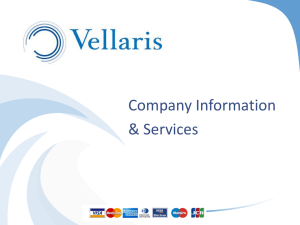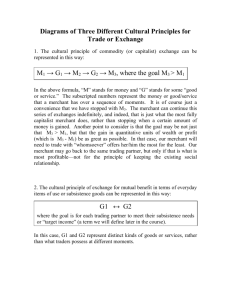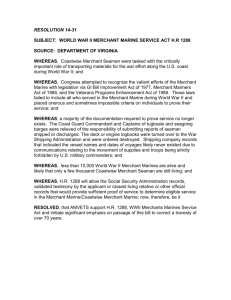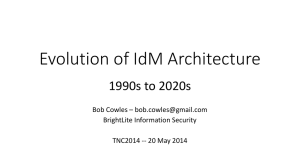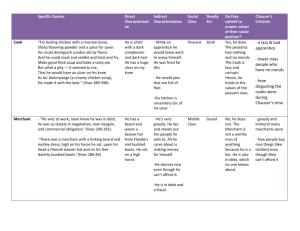PayMePayYou is able to code, test and demonstrate software that
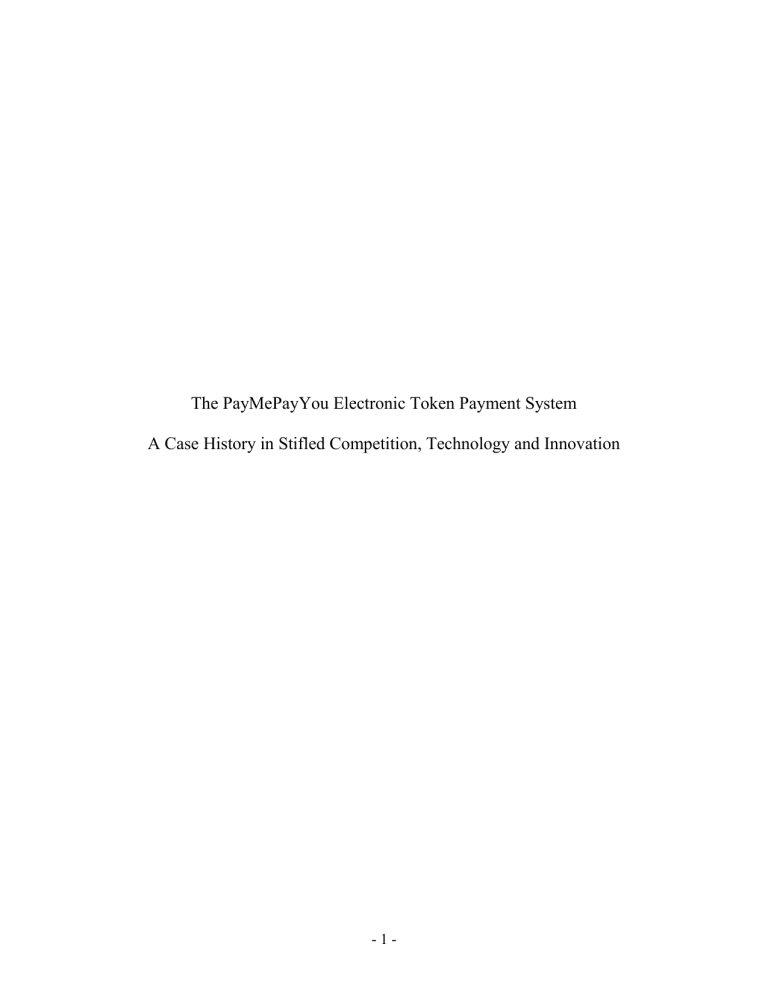
The PayMePayYou Electronic Token Payment System
A Case History in Stifled Competition, Technology and Innovation
- 1 -
Submission Preface PayMePayYou
Our submission to the Task Force outlines innovative new technology that many merchants, customers and bankers believe could quickly have a profound impact on the total world of commerce over the Internet. It simplifies the process, eliminates the need for credit cards and debit cards, reduces costs and eliminates any requirements for customers to provide credit or personal identification.
Our company welcomes the premises set out for the Task Force. In this preface we invite you look at the environment for innovative technology that appears to stifle payment innovation. This is due in large part to the inherent elements of our Banking System, a
Banking System that in many aspects is the best in the world.
Banks by nature worldwide are not innovative or risk takers. We are asking the task force to take under consideration a recommendation to the Minister of Finance or to the
Minister of Industry that when the greater good of the Commerce of Canada as determined by an appropriate Task Force is considered that they prevail upon our
Banking system to entertain new technology. This is contrary to the nature of banks but if in the interests of a wide array of the consumer public should be entertained.
Almost every current payment technology worldwide was developed by third parties and then given to the banks as additional vehicles for revenue generation. (VISA, MC PayPal etc.) Our technology as presented is totally integral to the Banks and cannot be launched independent of the Banking system. What we have developed represents 20+ man-years of research, systems programming, code development and testing. It now represents
Canadian innovation and intellectual property. Entrepreneurs and financiers are willing to back the launch of this product. A number of associations especially Merchants who are not well served by current payment facilities over the Internet are strongly supportive.
We offer immediate non-repudiable cash payment for goods and services deposited immediately in the merchants account. Our case does not appear to be able to garner a respectable hearing.
It has been made clear to us that none of the Canadian Banks are prepared to innovate technology that is not then made available to all Canadian banks on the same basis The
Canadian banking system has been described as an oligopoly that is immune to being receptive to change.
Our product concepts have been presented across a wide spectrum of International Banks including the largest bank in the world and the largest US Bank. It became obvious that the key necessary ingredients to do a national launch as set out in our presentation were here in Canada. We have several invitations to launch our product in other countries IF we are able to get it working in Canada. Worldwide we believe that an opportunity exists for this Canadian Technology that exceeds the Canadian implementation of debit.
The Banks created Interac to oversee and create credit card & debit card financial systems which would be common and communicate with all the major banks. It is responsible to all of the Bank members and offers technology on the same basis to each.
- 2 -
All payment technologies for the Canadian banking system have to be approved and implemented by Interac. Consequently the Interac workloads are heavy and approval processes laborious. The appetite for innovative technologies is not the same as if it were just one bank experimenting with a new solution.
Interac pioneered the use of Debit and thanks to the work of Interac, Canada is a world leader in providing cost effective debit. The premise of debit is that money can be withdrawn from a customer’s bank account directly to a third party under controlled conditions. However done, such access affords various windows for potential fraud. A study of our presentation will substantiate why for eCommerce over the Internet our token-based technology is more powerful, cost effective and functional than any existing payment offerings.
We have had a number of very supportive meetings and presentations with industry, various associations and several government departments. Several bankers in their individual capacities have urged us not to give up. The product represents innovation that would strongly benefit the total commerce world in Canada and to date we cannot generate the kind of hearing that is certainly appears to be warranted.
We would be happy to constructively work with the Task Force to develop recommendations that would allow for this kind of innovation with adequate public support to receive the kind of support that would appear warranted.
- 3 -
Executive Summary of the PayMePayYou Electronic Token System
For the past five years PayMePayYou has discussed this technology with the major
Canadian Banks who, individually, have been interested and encouraging. However, without the agreement of all the six major banks, no individual bank will entertain testing the Token system or spending any serious technical time to develop it.
Our experience in attempting to bring this innovative technology which could reduce fraud, and improve identity security while at the same time dropping transaction fees is a testimonial to a stifled competitive payment system in Canada.
We submit our payment system for your review.
The PayMePayYou Electronic Token Payment System will radically change the way that
Canadians are able to buy goods and services over the Internet. All of the crucial ingredients exist in Canada to make this technology practical, functional and simple for all parties. The technology does not directly compare to any currently offered Internet based settlement process.
The customer converts a limited amount of cash into an electronic token which is recognized and accepted as payment tender on the Internet by Web based merchants. The token is non transferable, not duplicable and has no intrinsic value. Upon receipt and validation of the electronic token, the merchant is prepared to release goods and services knowing full well that the payment by electronic token will be immediately converted to cash and deposited in his merchant’s bank account.
The system has the following characteristics:
1. The payment service is available to any on-line customer with high speed Internet access and to any merchant who wishes to sell goods and services and who also has high speed Internet connectivity.
2. The Web merchant receives cash credited to his bank account within seconds of a customer authorizing the purchase. The cash is non–repudiable just as cash from the customer’s ATM is non-repudiable.
3. No customer information: no credit card nor debit card numbers, nor pin numbers nor other information confidential to the customer, is conveyed to the merchant to complete the financial settlement of the sale.
4. The transaction, a transfer of money from the customer's bank to the merchant's bank is a part of the daily settlement process offered by the Canadian Payments
Association.
5. Since there is nothing of usable value that is transferred to or resides outside of the two banks, any window for fraud and identity theft is virtually non-existent.
- 4 -
Of crucial importance:- Since there is no credit processing associated with the
PayMePayYou solution, the monitoring and administrative costs associated with the security aspects of the card companies are eliminated . Consequently, the fees for the
PMPY services are relatively minimal when compared to the merchant fees for debit & credit cards. The lower fees make online sales more attractive to a greater number of merchants who previously were prohibited by the expensive discount fees.
- 5 -
Introducing PayMePayYou’s ‘Electronic Token’ Internet Payment System
PayMePayYou’s electronic token is a revolutionary new concept that has the potential to change the face of Internet commerce. Simple, fast, functional payments for goods and services over the Internet with no window for fraud and no reason for divulging credit or debit card numbers, pin numbers, passwords 3rd party credit or other information that ties a purchaser to any purchaser confidential information.
On-line purchases settled with credit cards, debit cards and other systems like PayPal are exposed to fraud and identity theft. These two security issues create an overbearing administrative function which must constantly monitor for fraudulent transactions and client information breaches. In addition, the handling of replacement cards and re-issuing security information are costly exercises. These huge security costs are passed on to the merchant.
With the advent of universally available high speed Internet and client computers that have gigabyte storage capabilities and instant nanosecond processing abilities, the
Internet can now facilitate a totally new approach to purchasing merchandise promoted on a merchant web site without the potential security exposures.
No Credit Cards, no pin numbers, no passwords, no need to provide any more information to the merchant than would be necessitated if the client presented a $100 bill for settlement of their purchase. With the PayMePayYou system, 90% of the security and fraud related costs normally associated with settling with debit & credit cards are eliminated. As a result, the merchant transaction fees can be minimal relative to current merchant discount fees for credit and debit cards.
Canada has the key ingredients to make this electronic token system functionally available on a national basis to every Internet merchant, and to every on-line customer.
These ingredients are:
1.
A small number of Banks that service 90% + of the consumer commerce.
2.
A not-for-profit inter-bank settlement entity (The Canadian Payments
Association).
3.
Widespread merchant Internet connectivity.
4.
Widespread ‘on-line’ consumer banking utilization.
A unique opportunity exists for the Canadian Banking system to lead the world by introducing this new technology.
- 6 -
The Major Benefits
1.
Fraud and identity theft are eliminated. Thereby removing the key inhibitors for customers who will embrace Internet shopping resulting in exponential sales growth.
2.
With reduced security monitoring fees drop dramatically creating lower costs for on-line merchants who can offer a broader selection of on-line product resulting in exponential growth in on-line sales..
3.
Non repudiation of cash transactions decreases banks customer service costs resulting in lower transaction fees.
4.
One click payment transactions by customers, reduces frustration and increases on-line sales, exponentially.
5.
With more on-line customers and dramatically reduced transaction fees, more merchants will open on-line sales web sites creating even more sales growth.
Advantages To customers purchasing goods and services over the
Internet.
Downloading cash under the PayMePayYou system is similar but simpler than getting funds from an ATM and much less costly to the bank.
Internet Clients can shop for purchases on-line with no personal financial identification, eliminating any fear of identity theft.
Purchase is made with one click of approval, avoiding the current customer identification and settlement processing requirements.
Customer can do all of their accounting on their own computer rather than looking to bank statements to confirm purchases.
If the merchant can only fill a portion of the order they can refund the over payment, returning the money to the customer’s bank account.
If a customer has computer problems, a call to his bank and unspent funds are redeposited to his account ready to download to another computer.
Customers can shop for unlimited micro-payment items for as little as $.10, $.25 or $1.00 e.g. music, a newspaper article or purchased information.
- 7 -
Advantages To merchants selling goods and services over the Internet
The sale is made over the Internet for non-repudiable cash exactly the same as if the customer offered physical cash at a point of sale.
The merchant can be credited with the total revenue from the sale to his bank account within seconds of the approval of the sale to the customer.
Anyone supporting a merchant’s web site will be able to download the software and introduce the merchant to its use.
Any individual wanting to sell a product or service can create a web site, request a license from his bank and is able to offer PayMePayYou capability.
The merchant does not need to interact with credit card processing systems to use the PayMePayYou settlement capability.
Merchants are able to create new incentives for customers e.g. Canadian Tire
Money to encourage and reward repeat business.
Digital content can be downloaded to a customer’s computer immediately on receipt of the approved token payment.
Low value products i.e. Ticket sales, licenses, books and music can all be sold over the Internet for cash without usurious fees.
Advantages To Banks
Issuing PayMePayYou payment ability is simpler, more efficient and less costly than issuing cash from a bank ATM.
Banks have NO legal exposure from PayMePayYou settlement, contrasting the exposure, expense and overhead associated with Internet credit & debit card settlement.
Banks can offer clients and merchants a new service that is cost effective, simple and very fast.
The Customers’ Banks hold the cash issued out of the client’s bank account, generating interest until redeemed by a merchant.
The bank can offer merchants the ability to have the proceeds from a sale deposited to their account immediately following a customer’s purchase.
No cash vests with a third party e.g. Card Processor or PayPal and is not given to the merchant other than as a deposit to his bank account.
The Canadian Payments System transfers payments from the customer’s bank to the merchant’s bank through the nightly settlement process.
The PayMePayYou payment process eliminates the usual money laundering and fraudulent windows of opportunity.
- 8 -
PayMePayYou System Description
Understanding how the system works.
Assume that it is two years after a successful launch. All systems are working as planned and the product has been widely accepted by the 6 major Canadian banks, 40,000 on-line
Canadian merchants, and 500,000 online customers.
For a transaction to occur, the appropriate PayMePayYou software must be resident on the customer’s computer, the customer’s bank server and the merchant’s sever and the merchant’s bank server.
PayMePayYou software applies to on-line purchases only and does not work in a POS environment.
The PayMePayYou software facilitates payments only. Each transaction results in the money being deposited to the merchant’s bank account. A customer cannot receive an electronic token from any other customer. An electronic token is specifically cross referenced to a customer and his designated bank account. One customer cannot transfer an electronic token to another customer’s computer. The electronic tokens must always be converted back to cash in every transaction and on every transaction that cash is deposited in the merchant’s bank account.
Customer’s View on Converting $200 from a regular bank account to a
$200 Electronic token and Purchasing a $20 electronic book on-line
At his bank, the customer designates an existing or new account as his PayMePayYou electronic banking account. This designation indicates to the bank from which account the PayMePayYou electronic token is purchased and to which any refunds of electronic tokens should be deposited.
The customer makes an on-line transfer of $200 from his designated bank account and a
$200 electronic token is transferred to the customer’s computer and appears as an electronic token bank account on his computer. Note that the actual $200 cash remains in the customers account in a special reserve, electronic token clearing account.
Knowing that he has a $200 token, the customer goes to the on-line book store and adds the $20 electronic book to his shopping cart and proceeds to checkout.
Interconnected, the customer reviews the invoice and if correct confirms his desire to purchase the book.
Upon checkout the customer is presented with several payment alternatives,
PayMePayYou, credit card, debit card, and PayPal. He selects PayMePayYou which automatically identifies the customer as a PayMePayYou customer
Without any other information or intervention, the PayMePayYou software resident with the online book store, detects that the customer is bone fide PayMePayYou customer and
- 9 -
verifies with the customer’s bank that there is a sufficient electronic token to cover the
$20 transaction and the transaction is approved and the customer’s available electronic token is reduced to $180 on his computer account. The purchased electronic book is immediately downloaded to the customer’s computer and an invoice is sent to the customer
Note that the customer was not required to enter any credit card numbers or other personal identity type information like name, address, telephone number or email address for the financial transaction.
The PayMePayYou software will deliver a paid in full receipt to the client’s computer for every item purchased with electronic cash regardless of the transaction size. At any time, the customer will have full details of every item purchased and can balance bank cash withdrawals to the receipts shown on the customer’s computer
Merchant’s View on Selling a $20 electronic book on-line
At his bank, the merchant designates an existing or new account as his PayMePayYou electronic banking account. This designation indicates to the bank to which account the cash should be deposited when the receipts of electronic tokens are converted back to cash.
Note that each electronic token payment transaction results in an immediate conversion from electronic token to cash which is individually deposited in the merchant’s designated PayMePayYou bank account.
The merchant’ software acknowledges the customer added the $20 book to the check out basket. The merchant presents an invoice for the total amount to the customer. The customer approves the Invoice amount. The customer selects the PayMePayYou payment option for the on-line purchase of the $20 book. The merchant’s PayMePayYou software confirms that the customer is a PayMePayYou customer with an electronic token. The
PayMePayYou merchant software automatically routes the token together with the payment authorization of $20 to his merchant bank. The merchant bank sends the token and payment authorization to the customer’s bank who verifies the validity of the token.
The customer’s bank cancels the original $200 token creates a new token $180 the remaining balance after the transaction. The customer’s bank transfers $20 from the electronic token clearing reserve and immediately it is credited to the designated
PayMePayYou bank account at the merchant’s bank.
- 10 -
Customer’s Bank’s View on Converting $200 from a regular bank account to a $200 Electronic Token and Purchasing a $20 electronic book on-line
When the customer converted $200 into a $200 electronic token, the customer’s bank transferred $200 into the electronic token clearing reserve with a specific cross reference tag to the customer’s electronic token which was transferred to the PayMePayYou account on the customer’s computer.
When the merchant’s bank presents the customer’s electronic token and the customer’s authorized purchase transaction for $20, the customer’s bank cancels the first electronic token for $200 and issues a new electronic token for $180. Then the $180 electronic token is forwarded to the merchant’s bank who in turn forwards it to the merchant, who in turn forwards it back to the PayMePayYou account on the customer’s computer.
Immediately, the customer’s bank transfers $20 to the merchant’s designated bank account. The original $200 in the clearing account is reduced to $180 with a new reference which agrees to the reference and electronic amount on the customer’s computer.
Remember that all of these transactions occur within milliseconds while the customer’s computer and the merchant’s server are interconnected during the purchase transaction.
Note that the cash flows from the customer’s bank’s electronic token clearing account directly to the merchant’s designated PayMePayYou account in the merchant’s bank.
Merchant’s Bank’s View on Converting $200 from a regular bank account to a $200 Electronic Token and Purchasing a $20 electronic book on-line
The merchant’s bank receives a payment authorization request for $20 from the customer’s PayMePayYou computer software along with the $200 electronic token.
The merchant’s bank forwards the $200 electronic token and the payment authorization from the merchant for $20 to the customer’s bank.
The customer’s bank confirms that the transaction is authorized, cancels the $200 electronic token and issues a new electronic token for $180 cross referenced to the customer. The customer’s bank returns the new $180 token to the merchant’s bank who confirms the transaction to the merchant and forwards the new $180 electronic token to the merchant who in turn sends it to the customer’s computer.
- 11 -
The merchant than downloads the electronic book and sends an invoice to the customer.
The merchant’s bank receives the $20 cash transfer from the customer’s bank and deposits it to the merchant’s PayMePayYou designated account.
The Flow of Cash
The customer’s cash, $200, is first transferred to an electron token clearing account where the $200 is clearing identified as being cross-referenced to the $200 electronic token which was sent to the customer’s computer.
When the customer’s $20 purchase authorization is received by the customer’s bank, the
$20 is transferred from the electronic token clearing account to the merchant’s specific
PayMePayYou designated bank account.
Upon this $20 transfer, the original $200 electronic token is cancelled and replaced with a new electronic token for $180 which is cross referenced with the corresponding $180 which is in the electronic token clearing account.
Note that the cash is transferred from the customer’s designated PayMePayYou account to an electronic token clearing account at the customer’s bank. When the purchase transaction is authorized by the customer, the $20 is transferred from that electronic token clearing account to the merchant’s designated PayMePayYou bank account at the merchant’s bank. The transaction is between known bank accounts.
The Flow of the Electronic Token
When the customer converts $200 cash from his designated PayMePayYou bank account, the bank sends a $200 electronic token to the customer’s computer.
When the customer authorizes the $20 purchase transaction on the merchant’s website, the entire $200 electronic token is transferred to the merchants PayMePayYou software on the merchant’s website. The $200 electronic token along with the $20 payment authorization are then forwarded to the merchant’s bank for authorization and payment settlement.
The merchant’s bank in turn sends the $200 electronic token to the customer’s bank along with the $20 payment authorization.
The customer’s bank cancels the original $200 electronic, replacing it with a new electronic token for $180 which is sent back to the merchant’s bank and transfers $20 cash to the merchant’s designated PayMePayYou bank account.
The merchant’s bank forwards the new $180 electronic token to the merchant who in turn forwards it to the PayMePayYou account on the customer’s computer.
- 12 -
PayMePayYou welcomes any dialogue or questions on the components necessary to make this PayMePayYou service available across Canada.
Email our CEO, Warren.Beamish@PayMePayYou.com
. or our President, John A. Craig, johnacraig2@rogers.com
- 13 -


